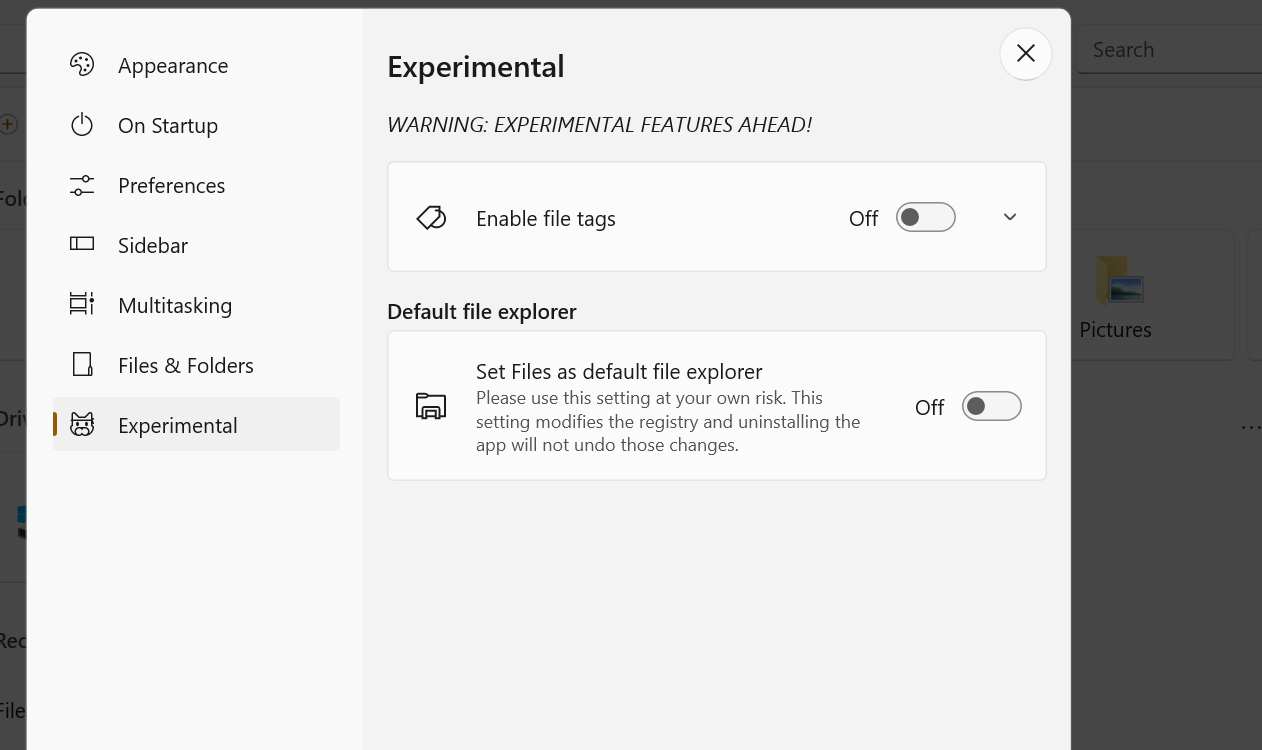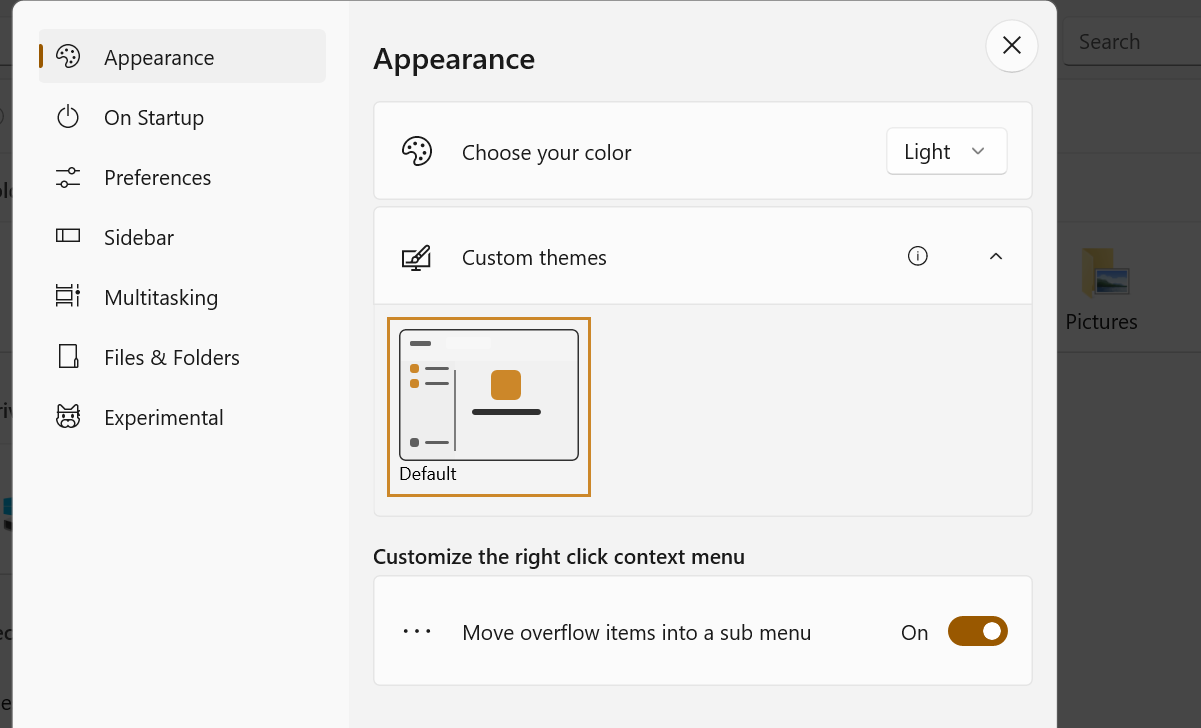If File Explorer doesn't do it for you, Files definitely will. Here's how to get started with it.
Readers like you help support MUO. When you make a purchase using links on our site, we may earn an affiliate commission. Read More.
One of the best things about using Windows is the open nature of the platform. You can install any third-party app you want, even the ones that change the default system functions. One such app is Files.
Files is an open-source, community-developed file manager for Windows. From the granular customization options to robust features, Files packs a lot of functionality not found in Windows’ default file manager. So, let's explore how to install and use Files, and how to set it as your default file explorer.
How to Change the Default Windows File Explorer to Files
Previously, you couldn’t use Files as the default file explorer. Fortunately, with version 2.0.34.0, Files added the feature to make it the default file explorer on Windows.
First up, download and install Files. It is available for free on the Microsoft Store.
Next, open Files and press the gear icon in the top right corner. This will open up the settings menu.
In the left sidebar, go to Experimental, and under Default file explorer toggle the Set Files as default file explorer on.
However, before you set Files as your default app, it's worth noting that you can’t just delete the app later and expect the changes to revert automatically. If you want to revert to the default Windows File Explorer, make sure you retrace the above steps and toggle the Files' default setting Off.
Related: Is Your Windows File Explorer Not Responding? Try These Fixes
Files Has a Lot of Useful Features to Play With
Aside from looking modern and minimalist, Files has a lot of other useful features. For instance, you customize the look by opening up the settings panel and navigating to Appearance. Here you can change the color scheme and can even set custom themes.
Moreover, you can also customize the explorer’s sidebar from inside the settings menu. You can toggle individual sections on or off depending on your needs.
Files is a great alternative to Windows File Explorer. It is fast, simple, and loaded with powerful features. But perhaps the best thing about it is its open-source nature. And because it is open-source, it will keep improving.
While Files adds many extra features, the vanilla File Explorer is also quite robust if you know how to use it. Learning the tips and tricks to enhance Windows File Explorer has the potential to supercharge your Windows experience.
FAQs
To check it out in Windows 10, select its icon on the taskbar or the Start menu, or press the Windows logo key + E on your keyboard.
What is the first step to open the File Explorer? ›
To open File Explorer, click on the File Explorer icon located in the taskbar. Alternatively, you can open File Explorer by clicking on the Start button and then clicking on File Explorer.
What are 4 tasks you can do in File Explorer? ›
File Management -- Common Tasks
- Finding Your Files.
- Opening a File.
- Copying a File (or Folder)
- Moving a File (or Folder)
- Deleting a File (or Folder)
- Selecting Multiple Files (or Folders)
- Zipping (Compressing) a Folder.
Click the File Explorer icon. Quick Access appears, which provides quick access to commonly used folders. You can also click the Start button, and then choose File Explorer. + E to open File Explorer.
What is Windows Explorer question and answer? ›
Microsoft Windows Explorer is a graphical file management utility for the Windows operating system (OS). Windows Explorer was introduced with Windows 95 and later renamed File Explorer. Each time that a computer user accesses a disk or opens a folder containing files, they are using the Windows/File Explorer utility.
What are the three ways to open Windows Explorer? ›
A few different ways of opening File Explorer include the following:
- Click. ...
- Press ⊞ Win + E .
- Right-click Start. ...
- Click Start.
File Explorer, previously known as Windows Explorer, is a file manager application that is included with releases of the Microsoft Windows operating system from Windows 95 onwards. It provides a graphical user interface for accessing the file systems.
What are the steps to open a file? ›
Open a file
- Open File Explorer and double-click the file, or right-click the file and select Open.
- Open the Office app you created the file in, and select the file from the Recent list.
Six basic file operations. The OS can provide system calls to create, write, read, reposition, delete, and truncate files. Creating a file.
What are the 3 basic types of file management? ›
The types of files recognized by the system are either regular, directory, or special. However, the operating system uses many variations of these basic types. All file types recognized by the system fall into one of these categories. However, the operating system uses many variations of these basic types.
What Does Ctrl+Z Do in File Explorer? Pressing the Ctrl+Z key combination can restore the last thing you clicked, typed, or changed to its previous state. It's faster than clicking the Edit > Undo feature!
How to open File Explorer in Windows 10 using command prompt? ›
If you like working with Windows Terminal, Command Prompt, or PowerShell, type the command explorer in any of them and press Enter. This immediately opens File Explorer from CMD in Windows 11 and Windows 10 or Windows Explorer in Windows 7.
How do I fix Windows 10 File Explorer is working? ›
How do I fix File Explorer problems in Windows 10?
- Restart File Explorer in Task Manager.
- Manually Restart the Explorer.exe Process via Command Prompt.
- Run System File Checker Scan.
- Clear File Explorer History.
- Change Display Settings.
- Extend System Partition If It Is Full.
- Create a New User Account.
It's called File Explorer in Windows 10. Here are three ways to open it: Select the Start button and find it on the Start menu.
What are the two main functions of File Explorer? ›
The searching feature in File Explorer provides an advanced search mechanism that can search for a file or data based on various attributes. File Explorer also enables the creation and addition of folders within Libraries, better control and maneuverability of multimedia files, SkyDrive integration and more.
What are the four main folders in Windows Explorer? ›
File Explorer comes with four libraries: Documents, Music, Pictures, and Videos. The Documents library, for example, includes files and folders from your Documents—This PC and SkyDrive (New!) —folders, which are actually stored in your Users folder.
How does File Explorer work? ›
It provides a graphical interface for the user to navigate and access the files stored in the computer. The main way to access the File Explorer is by clicking the folder icon in the Taskbar. After clicking the icon, the File Explorer window will open.
What is Ctrl N in File Explorer? ›
Open a New Window with the Same Folder
Ctrl + N will essentially duplicate the File Explorer window you are currently in.
What are the four methods of organizing files? ›
File organization methods
- sequential,
- random,
- serial and.
- indexed-sequential.
Sequential file organization in DBMS is the simplest of all file organization methods. In the case of large volumes of data, this method is efficient in terms of speed as access to the data is relatively fast in this method.
Best Practices For Organizing Computer Files to Save Time
- Stop Using Your Downloads Folder to Store Documents. ...
- Don't Save Things to Your Desktop. ...
- Don't Nest Too Many Folders. ...
- Use Descriptive File Names. ...
- File Things Immediately. ...
- Do Weekly Sorting & File Cleanup. ...
- Don't Go crazy With Too Many Folders.
A file is an object on a computer that stores data, information, settings, or commands used with a computer program. On a computer there are three types of files, application files, data files, and system files.
Why is it called file? ›
The word "file" derives from the Latin filum ("a thread"). "File" was used in the context of computer storage as early as January 1940.
What is file answer in one word? ›
A file is a container in a computer system for storing information. Files used in computers are similar in features to that of paper documents used in library and office files.
What are the 4 types of files? ›
6 Different Types of Files and How to Use Them
- JPEG (Joint Photographic Experts Group) ...
- PNG (Portable Network Graphics) ...
- GIF (Graphics Interchange Format) ...
- PDF (Portable Document Format) ...
- SVG (Scalable Vector Graphics) ...
- MP4 (Moving Picture Experts Group)
5 types of document files
- Portable document format (PDF) A PDF file is a common file type in many work environments. ...
- Word document (DOC and DOCX) ...
- Hypertext markup language (HTML and HTM) ...
- Microsoft excel spreadsheet file (XLS and XLSX) ...
- Text file (TXT)
Double-click a folder.
What are the 2 basic types of files? ›
There are two types of files. There are Program files and Data Files. Program files, at heart, can be described as files containing software instructions. Program files are then made up by two files called, source program files and executable files.
What is a master file? ›
A collection of records pertaining to one of the main subjects of an information system, such as customers, employees, products and vendors. Master files contain descriptive data, such as name and address, as well as summary information, such as amount due and year-to-date sales.
What are the five file processing techniques? ›
File Types and Processing Methods
- Relative-record-number processing.
- Consecutive processing.
- Sequential-by-key processing.
- Random-by-key processing.
- Sequential-within-limits processing.
Files can be opened in two ways. they are: Using the constructor function of the class. Using member function open of the class.
What is the difference between a file and a folder? ›
A file is the common storage unit in a computer, and all programs and data are "written" into a file and "read" from a file. A folder holds one or more files, and a folder can be empty until it is filled. A folder can also contain other folders, and there can be many levels of folders within folders.
Does Ctrl Shift Z do anything? ›
Use Ctrl-Shift-Z to redo actions.
What is the use of Ctrl Shift L? ›
2. CTRL+SHIFT+L – Turn on/ off filters.
What does Shift Z do? ›
Command-Z: Undo the previous command. You can then press Shift-Command-Z to Redo, reversing the undo command. In some apps, you can undo and redo multiple commands.
How do I manually start Windows Explorer in Windows 10? ›
Just press Ctrl+Shift+Esc to open Task Manager. Click the File menu and then choose “Run new task” in Windows 8 or 10 (or “Create new task” in Windows 7). Type “explorer.exe” into the run box and hit “o*k” to relaunch Windows Explorer.
How do I start Windows Explorer from keyboard? ›
To open the File Explorer window, simply press the Windows button ⊞ + E .
What is the shortcut key for opening a Windows Explorer? ›
How do I start Windows 10 from scratch? ›
To reset your PC, go to Start > Settings > Update & Security > Recovery > Reset this PC > Get Started.
How do I reset File Explorer to default settings? ›
To reset Windows 10 File Explorer to the default view – on the Folder views section of the Views tab, click Reset Folders. You will receive a confirmation pop-up.
Current keyboard shortcut for deleting files is Ctrl+D to conform with Windows File Explorer.
What does Ctrl B do in Windows Explorer? ›
Ctrl+B Bold highlighted selection. Ctrl+C Copy selected text. Ctrl+D Open the font preferences window. Ctrl+E Aligns the line or selected text to the center of the screen.
What does Ctrl R do in Explorer? ›
Ctrl+R in an Internet browser
In all major Internet browsers (e.g., Chrome, Edge, Firefox, Opera), pressing Ctrl + R refreshes (reloads) the current web page.
What does Ctrl F12 do? ›
Ctrl + F12 opens a document in Word. Shift + F12 saves the Microsoft Word document (like Ctrl + S ). Ctrl + Shift + F12 prints a document in Microsoft Word. Open Firebug, Chrome Developer Tools, or other browsers debug tool.
What does Ctrl S do in File Explorer? ›
Alternatively referred to as Control+S, ^s, and C-s, Ctrl+S is a keyboard shortcut often used to save changes to a file. On Apple computers, the keyboard shortcut used to save is Command + S .
What does Ctrl F7 do on Windows? ›
Groove keyboard shortcuts
| Press this key | To do this |
|---|
| F9 | Volume up |
| F8 | Volume down |
| F7 | Mute volume |
| Ctrl + Enter | Select an item and enter selection mode |
9 more rows

